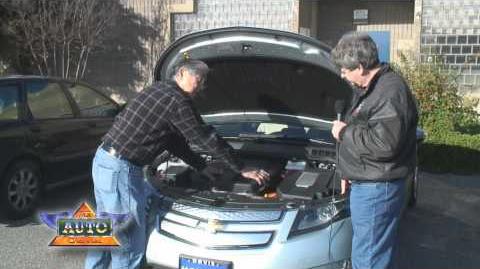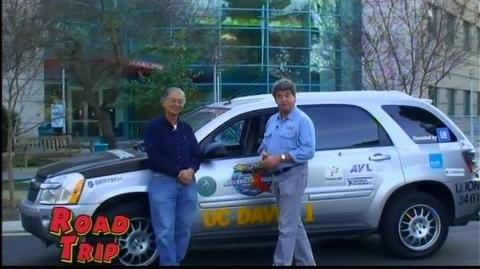
Dr. Andrew A. Frank ("Andy Frank") is Professor Emeritus in Mechanical and Aeronautical Engineering at University of California, Davis. [1] He is widely recognized as the Father of the Modern Plugin Hybrid Electric Vehicle (PHEV) based on the many patents and research publications that his work on electric vehicles has produced since 1971. [2] In addition to his ongoing work at UC Davis, Andy Frank is also a founder and Chief Technology Officer at Efficient Drivetrains, Inc. where they are producing continuously variable transmissions for all types of electric vehicles, including cars, trucks and buses.
PHEV Vehicles of the Future[]
PHEVs can become the primary vehicles for the future of transportation in our society, not just a short-term transition vehicle on the way to some other future vehicle type. [3] [4] PHEVLERs are defined as PHEVs with sufficient battery capacity for all electric driving of twice the average daily distance. [5] [6]
1. PHEVs can help reduce climate change by using fuel sources that don't produce greenhouse gas pollution. PHEVs can be fueled from sustainable, renewable energy soures (electricity generated from wind and solar, and renewable liquid biofuels) to replace the fossil fuel energy sources of the past. [7] [8] [9] [10] [11] [12] [13]
2. PHEVs are green vehicles that can use liquid biofuel instead of gasoline and diesel fossil fuels. The first generation biofuels of today are far from perfect, [14] but they lead to a great potential for clean, green, sustainable, renewable, second generation biofuels. [15] [16] Biofuels take CO2 from the air when they are produced which compensates for the CO2 released to the air when they are burned. PHEVs fueled from these advanced biofuels and a clean electrical grid will contribute to a cleaner environment in the future. There is not enough land available to grow sufficient biofuels to become the exclusive fuel for all of our internal combustion engine vehicles. If we transition to use of PHEVs in the future, then we can grow sufficient biofuels for occasional use in PHEVs that would be fueled mostly by electricity. Biofuels are low-carbon fuels which will "decrease carbon dioxide emissions associated with liquid fuel-powered vehicles considering the entire life cycle ('well to wheels'), in order to reduce the carbon footprint of transportation." [17] Thus, the best of the PHEVs are included wherever green vehicles are listed. [18] [19] [20]
3. PHEVs use the existing infrastructure for energy distribution (electrical grid and liquid fuel pipelines). Discount prices can encourage charging of electrical vehicles at off-peak times when excess electrical generating capacity is available. [21] Every place with 110V electrical service and a long extension cord can serve as a slow Level 1 charging station for electrical vehicles. Slightly faster Level 2 (240V) electrical charging stations can easily be set up wherever needed. Our network of liquid fuel pipelines and gasoline stations can be repurposed for distribution of biofuels. Thus, much of the infrastructure needed for widespread use of clean fuels and PHEVs is already available to make PHEVs practical vehicles for today and tomorrow.
4. PHEVs are dual fuel vehicles which makes them adaptable and capable vehicles. PHEVs switch automatically from electricity to liquid fuel whenever the distance traveled exceeds the capacity of the battery. [22] [23] [24]
5. PHEVs have no range limitation or range anxiety. Current and foreseeable future battery technologies likely will limit all-electric vehicles primarily to short distance travel in and around urban areas. [25] Rapid refueling and long distance vehicle travel in rural areas will require liquid fuel vehicles like PHEVs and internal combustion engine vehicles for the foreseeable future.
6. Simple electric vehicles are not yet practical for long distance transportation or for everyone who owns a gasoline vehicle today due to a lack of infrastructure. Some concepts have been proposed but have to be accepted and proven to be practical from every aspect. a) Rapid charging stations [26] and battery swapping stations for electrical vehicles would require massive new infrastructure investments to make them as widely available as gasoline stations are now. Rapid charging stations require very high power and very large amounts of electricity to provide that convenience, so widespread use of rapid charging would also require additional large infrastructure investments to provide much more electricity generation and transmission capacity. Rapid charging and battery swapping infrastructure is likely to be limited to urban areas and high traffic corridors. It may never make economic sense to build this infrastructure in rural areas. b) Advances in battery technology that allow electric vehicles to travel long distance before needing to recharge may be eventually be discovered in the future, but nobody can predict when, if ever, those discoveries might be made. Experiments currently in the laboratories will take at least 10 years to be adopted in industry.
7. The PHEVs of today are practical and efficient long distance vehicles using our existing infrastructure at low power because they are dual fuel vehicles and are designed to use electricity first before they use gasoline. PHEVs will be green vehicles helping to protect the climate when fueled with electricity and second generation biofuels from sustainable, renewable sources of power. On the other hand, simple electric vehicles and the new infrastructure that they would require may not become practical and affordable for long distance transport in the foreseeable future. In fact the high power chargers will make the electric generation and distribution system less efficient. The high power utility factor will always be low, thus raising the cost of electricity for everyone. On the other hand the PHEV charging at low power when parked can increase the utility factor and thus efficiency of the electric generation and distribution system and thus lower the cost of electricity to everyone.
2004 International Continuously Variable and Hybrid Transmission Congress[]
Dr. Andrew A. Frank & his Team FATE students organized the 2004 International Continuously Variable and Hybrid Transmission Congress to discuss: Theory of CVT Systems, New Concepts for CVT's, Modeling CVT Systems, Low Level Control of CVT's, Theory in CVT Applications, CVT Concepts, Experimental Effects and Developments, New Concepts and Geometries, Rubber Belt and other Configurations, High Level Control, Hybrid Electric CVT's.
- Comparison of Energy Consumption and Power Losses of a Conventionally Controlled CVT with a Servo-Hydraulic Controlled CVT and with a Belt and Chain as the Torque Transmitting Element, Andrew A. Frank, Siddarth Shastri - University of California HEV Center, abstract, paper, presentation
- The Design of an Inline GCI Chain CVT for Large Vehicles, Andrew A. Frank - University of California-Davis, Jacques van Rooij - GCI BV, abstract, paper
- Engine Optimization Concepts for CVT-Hybrid Systems to Obtain the Best Performance and Fuel Efficiency, Andrew A. Frank - University of California-Davis, abstract, paper
Videos[]

Chevrolet Volt Reviewed by the Father of the Plug-In Hybrid-0
Chevrolet Volt Reviewed by Andy Frank, the Father of the Plug-In Hybrid Electric Vehicle (PHEV).

RoadTrip Plug-In Electric Chevrolet Equinox-1
Dr. Andy Frank from UC Davis talks about his pioneering and revolutionary work on the plug-in electric vehicle prototype based on a modified Chevrolet Equinox.
References[]
- ↑ Prof. Andrew A. Frank, Dept. Mechanical and Aerospace Engineering, University of California, Davis
- ↑ AA Frank publications and patents - Google Scholar profile
- ↑ 2013 Ford C-Max Energi Quick Drive - Automotive News 19nov2012
- ↑ Frank, Andrew A. and Catherine J. DeMauro (2015) Using the PHEV (Plug-in Hybrid Electric Vehicle) to Transition Society Seamlessly and Profitably from Fossil Fuel to 100% Renewable Energy. Green Car Congress (17 July 2015)
- ↑ PHEVLER - EAA-PHEV Wiki
- ↑ PHEVLER - Wiktionary open content dictionary
- ↑ A Fifteen Year Roadmap toward Complete Energy Sustainability by Watson and Frank (2012), Institute of Transportation Studies, Davis, CA
- ↑ Plug-In Hybrid Electric Vehicles Help Towards a Zero-Carbon Emissions Future by AA Frank (2009), Institute of Transportation Studies, Davis, CA
- ↑ Bradley, Thomas and Andrew A. Frank (2009) Design, Demonstrations and Sustainability Impact Assessments for Plug-in Hybrid Electric Vehicles. Renewable & Sustainable Energy Reviews 13 (1), 115 - 128
- ↑ Frank, Andrew A. (2007) Plug-in Hybrid Vehicles for a Sustainable Future. American Scientist 95 (2), 158 - 165
- ↑ Romm, Joseph and Andrew A. Frank (2006) Hybrid Vehicles Gain Traction. Scientific American 294 (4), 72 - 79
- ↑ Plug-In Hybrids: The New Focus for the Future of Transportation - RenewableEnergyWorld 03march2006
- ↑ Why Vehicles Need to use Electricity - Electric Auto Association - PHEV wiki
- ↑ First Generation Biofuel - Green Wiki
- ↑ Second Generation Advanced Biofuel - Green Wiki
- ↑ Renewable biofuels replace fossil fuels to help reduce climate change - AAFrank at YouTube
- ↑ Low-carbon fuel standard - Wikipedia
- ↑ Green Vehicle Guide - US EPA
- ↑ Green Vehicle Guide - .gov.au
- ↑ Electric Vehicle Guide - SIERRA
- ↑ U.S. Electricity Generators Can Handle Electric Car Load, For Now | PluginCars.com 22march2011
- ↑ Plug-in Hybrids Are the Future; Not Hydrogen, Not Electric - Energy Tribune 29nov2012
- ↑ Are PHEVs The Future or Just a Transition Vehicle? - C-MaxChat 07dec2012
- ↑ Plug-in hybrid electric vehicles are the future; not hydrogen, not pure electric vehicles - The Chronicle Herald 28nov2012
- ↑ Life on the edge of the electric car ecosystem: A desperate drive from charge to charge | TechHive 09oct2013
- ↑ Understanding Electric Vehicle Charging | Plug In America